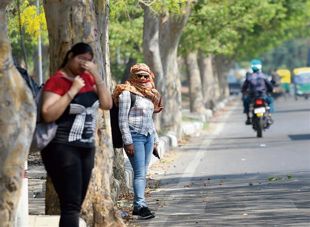A sign reads 'Dry Chamber' during the periodical maintenance of the West Lane of Pedro Miguel locks at the Panama Canal, in Panama City, Panama, on May 12, 2023. Reuters file
Vibha Sharma
Chandigarh, August 26
On March 23, 2021, the Suez Canal remained blocked for six days due to the Ever Given—a container ship that had run aground in the canal. By March 28, around 370 ships had queued up, stranding around $9.6 billion world trade in the canal.
By the time the Suez reopened, around 200 in the Red Sea, some 200 in the Mediterranean Sea and approximately 50 in the Bitter Lakes, were said to be caught up in the “traffic jam”, according to reports.
The Suez Canal is one of the world’s most important trading routes, connecting the Mediterranean Sea to the Red Sea through the Isthmus of Suez and dividing Africa and Asia.
While the traffic jam in the Suez was caused by a ship, the one currently on near the Panama Canal is due to climate change.
The effect of climate change and global warming is no longer a thing of the future, real-time impacts of climate change have already started affecting world economy and trade, say observers.
Panama Canal Authority imposes transit restrictions
Due to low water levels in the lock system, the Panama Canal Authority, the agency of the government of Panama responsible for the operation and management of the Panama Canal, has imposed transit restrictions in the key route connecting the Atlantic Ocean with the Pacific Ocean, dividing the North and South America.
Ships waiting for their turn have again raised questions whether it was the time for an alternative route to the Panama Canal which plays a key role in maritime transport.
Due to water-level issues, the canal operations are expected to remain restricted for up to a year, according to reports.
The waiting time to enter is up to 11 days on an average from the earlier three to five days.
According to the official website, “the prolonged dry season is a natural phenomenon that affects many regions, including the Panama Canal. While we can’t control nature, we can adapt our operations to ensure a competitive flow of vessels”.
“To provide perspective, as of today, we have around 120 vessels waiting for transit.
“For this month, the average waiting time for unbooked transits is between 9 and 11 days.
“The backlog currently sits at about 115 vessels,” as per the website.
The restrictions are expected to cause a drop of $200 million drop earnings in 2024 compared to this year, some independent reports state.
The key maritime route
The canal authorities which first announced restrictions for this year later extended it to “at least 10 additional months”. According to ground reports, ships loaded with consumer goods, oil/ gas, grain and other items are waiting for their turn at the canal through which an estimated $270bn worth of cargo passes each year.
Apparently, some ships have also decided to take detours to avoid the delays, decisions that are expected to push up freight costs and affect consumer prices.
Owners have been advised to make reservations to avoid delays.
Experts say the event is “unprecedented and a cause for concern”. It is perhaps time to consider another way to get from the Pacific to the Atlantic in mind of climate change, they add.
Reducing time for ships to travel between the Atlantic and Pacific oceans, avoiding a lengthy route around the southernmost tip of South America, the Panama Canal is called one of the “largest and most difficult engineering projects ever undertaken”.
Panama Canal, the 'engineering marvel’
Canal operations depend upon lakes where the levels are said to be “close to the minimum” due to rain deficit.
The complicated canal lock system lifts ships up to artificial freshwater lakes and then lowers them at the other end.
Transporting ships through the system of locks consumes vast amounts of fresh water. A ship requires around 200 million liters of freshwater to move it through the locks. The water is provided by two artificial lakes which supply the canal and also provide drinking water. The lakes are the main source of drinking water for the Panama city.
Panama Canal facing drought
Panama is facing a drought which has been made worse by the El Nino phenomenon.
Many maritime experts say the drought in the middle of Panama’s wet season is “unusual”.
The US also had the choice to build a canal across Nicaragua but Panama was selected since the route was shorter, and for other geographical reasons. However, the climate crisis has rekindled thoughts of an alternate route to save time and billions of dollars.
Experts say the “unprecedented dry season” in the region led to a significant decline in water levels in the canal, which needs fresh water for operations.
Since much of the freshwater gets drained in the sea, the authorities are now using methods to store and reuse some of it. There are also plans of diverting water from other rivers and constructing additional reservoirs, according to reports.
Join Whatsapp Channel of The Tribune for latest updates.




























